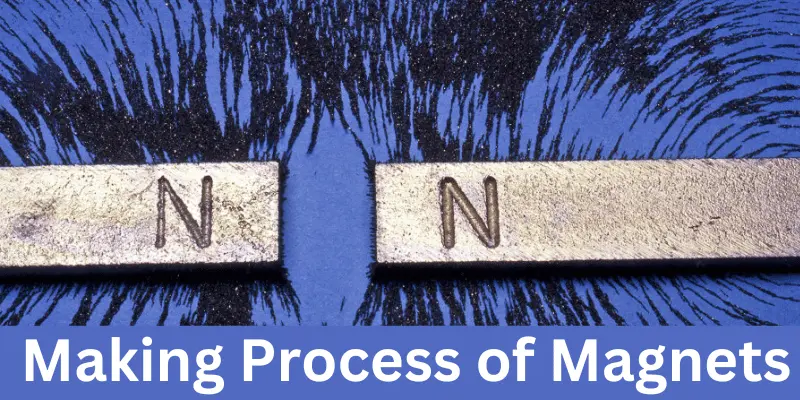Magnetic Materials | What Materials Are Attracted By Magnets – Benefits
Updated: 14 Oct 2024
643
Have you ever played with a magnet and noticed it could stick to some objects but not others? Magnets Materials are cool because they can pull certain metals towards them, almost like magic! But did you know that not all materials are attracted to magnets? In this blog, we’ll learn about the types of metals that magnets love to stick to and why some things don’t attract magnets at all.
Table of Contents
What Materials Are Attracted by Magnets?
Magnets are objects that can pull certain materials toward them. However, not all metals stick to magnets. Some common metals that are attracted by magnets include:
- Iron: Found in nails and tools.
- Nickel: Used in coins and batteries.
- Cobalt: A less common metal but still magnetic.
Metals like aluminum, copper, and gold do not stick to magnets. Magnets work by pulling metals with special properties called magnetic domains, which only certain metals have.
Why Are Magnets Important?
Magnets are important because they help us in many ways. They make everyday things work, like fridges, computers, and even toys. Magnets are used in many machines, like motors and generators, to create electricity. Without magnets, many gadgets we use every day wouldn’t work! They also help scientists and doctors in special equipment like MRI machines to look inside the body. Learning about magnets helps us understand how things around us work and how we can use them to make life easier.
Types of Magnetic and Non-Magnetic Materials
1. Magnetic Materials
- Magnets are special objects that can attract certain materials, but not everything sticks to a magnet! Magnetic materials are usually metals that have the power to be pulled toward a magnet. Magnets materials have tiny magnetic areas inside them that line up when near a magnet, making them stick to it.
- These are materials that are attracted to magnets. They include
- Iron: Used in everyday items like nails and tools.
- Nickel: Found in some coins and batteries.
- Cobalt: A less common metal but still attracted by magnets.
- These are materials that are attracted to magnets. They include
2. Non-Magnetic Materials
- Non-magnetic materials are things that do not stick to magnets. This means they don’t have the special magnetic properties that attract magnets. When you use a magnet, you’ll notice it won’t pull non-magnetic materials toward it. Understanding which materials are non-magnetic helps us know how magnets work and where we can use them in our everyday lives.
- These materials do not stick to magnets:
- Copper: Often used in wires but not attracted by magnets.
- Aluminum: Found in soda cans, not magnetic.
- These materials do not stick to magnets:
3. Other Materials
- Plastic, Wood, Paper: Non-metallic materials that do not stick to magnets.
- Key Points
- Only certain metals like iron, nickel, and cobalt are magnetic.
- Most non-metals and some metals like copper and aluminum are not magnetic.
- How Do Magnets Work?
- Metals like iron, nickel, and cobalt have special areas called magnetic domains that align with the magnet’s pull, causing them to stick.
Making Process of Magnets
Have you ever wondered how magnets are made? Making magnets can be a fun and exciting project! Magnets are created from special materials that can attract metals like iron, nickel, and cobalt. There are different ways to make magnets, such as using electricity or rubbing certain materials together. In this blog, we will explore how you can make your own magnets at home and discover the science behind them. Get ready to learn and have fun with magnets.

- Types of Magnets
- Magnets can be made in different ways. There are two main types:
- Permanent Magnets: These magnets always stay magnetic.
- Temporary Magnets: These magnets only act like magnets when near a strong magnetic force.
- Magnets can be made in different ways. There are two main types:
- Materials Used
- Common materials used to make magnets include:
- Iron: Most magnets use iron because it is strong and easy to magnetize.
- Nickel and Cobalt: These metals can also be used in making magnets.
- Common materials used to make magnets include:
- The Making Process
- Making magnets involves a few steps:
- Step 1: Choosing Materials
- Start with iron, nickel, or cobalt.
- Step 2: Heating
- Heat the metal to a high temperature. This helps align the magnetic domains.
- Step 3: Magnetizing
- Use a strong magnet or electrical current to magnetize the metal. This aligns the magnetic domains.
- Step 4: Cooling
- Allow the metal to cool. This helps it hold its magnetic strength.
- Step 5: Testing
- Test the magnet by seeing what it can attract, like paperclips or nails.
- Step 1: Choosing Materials
- Making magnets involves a few steps:
Making magnets is an interesting process! By using special metals and following these steps, we create objects that can attract other metals.
Uses of Magnetic Materials
Magnetic materials are special substances that can attract certain metals, like iron, nickel, and cobalt. These materials have a unique ability to create a force that pulls them toward magnets. This force is called magnetism. You can find magnetic materials all around you, from the fridge magnets that hold notes to your refrigerator to the speakers in your favorite music devices. Understanding magnetic materials helps us learn how they work in everyday life and technology.
The magnetic materials use in items are include:-
- Electronics
- Home Appliances
- Tools and Equipment
- Transportation
- Magnetic Games
- Electronics
- Speakers: Magnets help create sound in speakers. They move back and forth to make sound waves.
- Microphones: Magnets convert sound into electrical signals, allowing us to record or amplify sound.
- Electric Motors: Magnets work with electricity to make motors spin. They power many machines and tools.
- Hard Drives: Magnets store data in computers. They help keep information safe and organized.
- Magnetic Sensors: Used in phones and tablets to detect motion or position, making devices respond to touch.
- Home Appliances
- Refrigerators: Magnets hold the refrigerator door closed tightly.
- Keeps food fresh by preventing cold air from escaping.
- Microwaves: Magnets create heat through a part called the magnetron.
- Heats food quickly and evenly.
- Washing Machines: Magnets help in the door lock mechanism.
- Ensure safety by keeping the door shut during washing.
- Vacuum Cleaners: Magnets hold the motor in place.
- Help in picking up metal objects from the floor.
- Speakers: Magnets create sound by moving a part called the diaphragm.
- Allow you to listen to music and sounds clearly.
- Refrigerators: Magnets hold the refrigerator door closed tightly.
- Tools and Equipment
- Refrigerators: Use magnets to keep doors closed. Magnets create a tight seal.
- Magnets for Crafts: Used in art projects to hold items together or attach to surfaces.
- Magnetic Tools:-
- Screwdrivers: Some have magnets to hold screws while working.
- Magnetic Hangers: Help hold tools on metal surfaces.
- Magnetic Tools:-
- Magnetic Toys: Fun toys use magnets to stick together, promoting creativity and learning.
- Computers and Electronics: Hard drives use magnets to store information.
- Transportation
- Trains
- Maglev Trains: Use magnets to float above tracks, allowing them to move very fast without touching the ground.
- Cars
- Magnetic Sensors: Help detect position and speed of wheels, improving safety and performance.
- Buses
- Magnetic Brakes: Used in some buses to stop quickly and safely without wear on regular brakes.
- Cargo Handling
- Magnetic Cranes: Lift heavy metal containers in shipping yards, making loading and unloading faster.
- Trains
- Magnetic Games
- Magnetic games are fun and educational. Here are some ways they are used:
- Learning About Magnets: Kids explore how magnets work and which materials stick to them.
- Developing Skills: Games help enhance coordination between hands and eyes while refining precise movement skills.
- Teamwork: Many magnetic games encourage kids to play together, teaching teamwork and cooperation.
- Problem-Solving: Players face challenges that require critical thinking and strategy to win.
- Creativity: Magnetic building toys let kids create unique designs and structures
- Magnetic games are fun and educational. Here are some ways they are used:
Metals That Attract to Magnets
Magnets attract some metals and not others. The metals that stick to magnets include iron, nickel, and cobalt. These special metals have properties that allow them to connect with magnets easily.
- Iron
- Most common magnetic metal.
- Found in tools, nails, and machines.
- Nickel
- Commonly found in coins and batteries.
- Sticks to magnets easily.
- Cobalt
- A rarer metal that is attracted to magnets.
- Used in special alloys and tools.
These metals have properties that allow them to be pulled by magnets. They are often used in everyday objects.
Metals That Don’t Attract Magnets.
Not all metals stick to magnets. Some common metals, like aluminum and copper, do not have magnetic properties and will not be attracted to a magnet. This means you won’t see them sticking when you bring a magnet close.

- Aluminum
- Commonly found in soda cans and foil.
- Light and durable, but does not stick to magnets.
- Copper
- Used in electrical wires and pipes.
- Good conductor of electricity, but not magnetic.
- Lead
- Soft metal used in batteries.
- Heavy and dense, but does not attract magnets.
- Tin
- Used to coat other metals.
- Light and resistant to rust, but not magnetic.
These metals cannot be picked up by magnets.
Advantages and Disadvantages of Magnetic Materials
Magnets are useful in many ways, but they also have some downsides. Understanding the advantages and disadvantages of magnetic materials helps us know how to use them safely and effectively in our everyday lives.
| Benefits of Magnetic Materials |
|---|
|
| Drawback Magnetic Materials |
|---|
|
Conclusion
Magnets are important tools that attract certain metals like iron, nickel, and cobalt. They have many uses, like holding things together and powering devices. However, not all metals are magnetic, and strong magnets can be dangerous if not handled carefully. Understanding how magnets work helps us use them safely and effectively in our everyday lives.
Please Write Your Comments